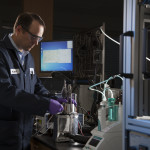New Baker Hughes lab focuses on deepwater chemicals reliability

Image courtesy of Baker Hughes.
By Katherine Scott, associate editor
Baker Hughes is further investing in the deepwater frontier with the opening of its new Upstream Chemicals Deepwater Laboratory in Houston on 25 April. Located within the company’s Center for Technology Innovation (CTI), the $4.5 million lab is dedicated to deepwater research, studies and testing.
“A lot of focus in this market talks about ‘no more easy oil.’ It’s been that way for quite some time,” Mark Lewis, vice president of upstream chemicals, said at the launch event. “In my view, deepwater is the definition of ‘no more easy oil.’ This means a need for exceptional technology developments in seismic, drilling, completions, production and production treatment as E&P companies push further out and push the envelopes of performance, particularly around HPHT.”
The lab features equipment to assess product reliability and quality, as well as performance of the company’s FATHOM subsea-certified chemicals, designed as deepwater flow assurance treatments. Through a 16-step deepwater subsea-certification process, the lab can confirm that each chemical product is qualified for subsea application through tests such as hydrate stability, high temperature thermal stability and chemical fluid compatibility. The FATHOM test is built on standards recommended by the Blockage Avoidance in Subsea Injection and Control Systems (BASICS) joint industry project and published in API specification 17A TR6.
Equipment in the lab includes a high-pressure rheometer, cloud point/pour point analyzer, proprietary high-pressure umbilical approval test loops, a high-pressure viscometer, temperature cycling ovens, a high-pressure density meter, particle size analyzer, visual hydrate rocking cells, a paraffin cold finger, high-pressure asphaltene flocculation tester, dynamic tube blocking equipment for scale and a core flood apparatus.
With water depths reaching 10,000 ft, pressures up to 30,000 psi, and temperatures of 400°F in some deepwater environments like the Gulf of Mexico’s Lower Tertiary, Ann Davis, director of deepwater solutions at Baker Hughes, said more needs to be done to operate in HPHT. “The industry currently doesn’t have all the necessary tools they need to manage these conditions. My team is hoping to take some lessons learned at CTI and expand our capabilities in the lab to be able to evaluate our products under those conditions. We’re also hoping to expand our FATHOM capabilities to be able to test our products at those conditions.”
Just a couple of days before the opening of the Houston lab, Baker Hughes also launched its new Center for Offshore Cementing, Fluids and Chemicals in Broussard, La. It is designed to support the continued growth of the deepwater market as well. The company envisions using the centers to collaborate on technological development. “We’re starting to push our capability in deepwater out to where the deepwater hubs are, ” Mr Lewis said. “The upstream personnel in Louisiana will work in tandem with the technologies that we develop both out of the Houston facility and in our Sugar Land facility.”
FATHOM is a trademark of Baker Hughes.







